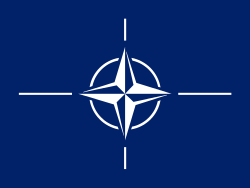Kommodore
- This article is about the German Nazi Kriegsmarine rank Kommodore (OF-5a), equivalent to Kapitän zur See (OF-5b). It should not be confused with the more senior Commodore (rank), which might be a one-star rank (
 NATO code of (OF-6), nor the position of a WW II Luftwaffe combat wing commander, known as a Geschwaderkommodore.
NATO code of (OF-6), nor the position of a WW II Luftwaffe combat wing commander, known as a Geschwaderkommodore.



Kommodore (pronounced kom-o-'dor-eh) was the highest senior officer rank (German: Stabsoffizier Rang) in the German Kriegsmarine, comparable to commodore in anglophone naval forces. According to modern armed forces it was the equivalent of the NATO OF-5 grade.[N 1] There was no counterpart in the German Heer and Luftwaffe, but Kommodore would have been comparable to Oberführer in the Waffen-SS.
Kriegsmarine rank insignia
The rank insignia consisted of shoulder strap and sleeve lace. Shoulder straps, corresponding to those of Kapitän zur See, had to be worn on uniform jackets and consisted of twisted silver braids with two gold pips (stars) on padding in navy blue Waffenfarbe. Cuff insignia consisted of one five-pointed star above a big gold lace. The sleeve rings encircled the lower cuffs.
The sequence of ranks in decreasing order of seniority was:
- OF-6: Flottillenadmiral / Brigadegeneral
- OF-5a: Kommodore / no Heer or Luftwaffe equivalent
- OF-5: Kapitän zur See / Oberst
History
Kommodore originated as a title used by some Kapitän zur See of the Kaiserliche Marine (Imperial Navy) in World War I.
A German Kommodore could hold any naval rank between lieutenant and captain and the title of Kommodore was held by those officers who held tactical control over more than one vessel. This was most common with U-Boat commanders in charge of several submarines that were assigned to a single task force. In the 19th century, German officers of this rank were referred to as fleet captains (Flottenkapitän).
By World War II, Kommodore had at last become an actual - though rarely used - rank in the Kriegsmarine. The position was considered that of a senior captain, with insignia being the shoulder boards of a Kapitän zur See with one thick admiral's rank stripe (52 mm) on the sleeve. German commodores also were permitted to wear greatcoat lapels and visor insignia of an admiral but were not officially members of the German admiralty. Probably the most prominent holder of this rank was Karl Dönitz, who became Kommodore and Führer der Unterseeboote (commander of submarines) on 28 January 1939; however, he held the rank for just over eight months until 1 October 1939, when he was promoted to Konteradmiral.
The World War II rank of Kommodore existed in a grey zone of seniority, since neither of the other two branches of the Wehrmacht (Heer and Luftwaffe) had equivalent ranks; thus, it was very similar to the S.S. rank of Oberführer.
After the fall of Nazi Germany, and the rebuilding of the German Navy, Kommodore fell into disuse as a rank, effectively being replaced by the Flottillenadmiral which is the lowest flag rank. It reappeared as a title in the 1950s. In the modern age, a German commodore is a senior captain who holds the rank of captain but holds such positions as a naval squadron commander.
| Junior rank Kapitän zur See |
(Kriegsmarine ranks) Kommodore |
Senior rank Konteradmiral |
Notes
- ↑ The abbreviation "OF" stands for "officer"; non-commissioned rank codes in NATO are prefixed with "OR" for "other ranks".